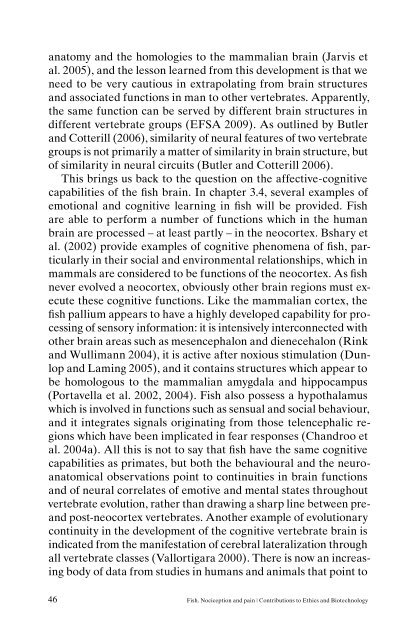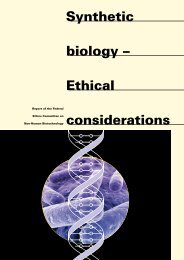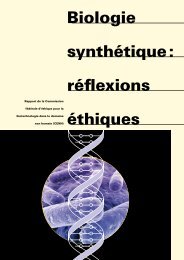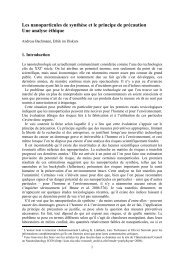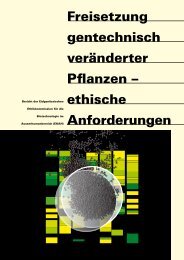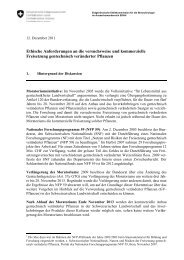Helmut Segner Fish Nociception and pain A biological perspective
Helmut Segner Fish Nociception and pain A ... - EKAH - admin.ch
Helmut Segner Fish Nociception and pain A ... - EKAH - admin.ch
- No tags were found...
You also want an ePaper? Increase the reach of your titles
YUMPU automatically turns print PDFs into web optimized ePapers that Google loves.
anatomy <strong>and</strong> the homologies to the mammalian brain (Jarvis et<br />
al. 2005), <strong>and</strong> the lesson learned from this development is that we<br />
need to be very cautious in extrapolating from brain structures<br />
<strong>and</strong> associated functions in man to other vertebrates. Apparently,<br />
the same function can be served by different brain structures in<br />
different vertebrate groups (EFSA 2009). As outlined by Butler<br />
<strong>and</strong> Cotterill (2006), similarity of neural features of two vertebrate<br />
groups is not primarily a matter of similarity in brain structure, but<br />
of similarity in neural circuits (Butler <strong>and</strong> Cotterill 2006).<br />
This brings us back to the question on the affective-cognitive<br />
capabilities of the fish brain. In chapter 3.4, several examples of<br />
emotional <strong>and</strong> cognitive learning in fish will be provided. <strong>Fish</strong><br />
are able to perform a number of functions which in the human<br />
brain are processed – at least partly – in the neocortex. Bshary et<br />
al. (2002) provide examples of cognitive phenomena of fish, particularly<br />
in their social <strong>and</strong> environmental relationships, which in<br />
mammals are considered to be functions of the neocortex. As fish<br />
never evolved a neocortex, obviously other brain regions must execute<br />
these cognitive functions. Like the mammalian cortex, the<br />
fish pallium appears to have a highly developed capability for processing<br />
of sensory information: it is intensively interconnected with<br />
other brain areas such as mesencephalon <strong>and</strong> dienecehalon (Rink<br />
<strong>and</strong> Wullimann 2004), it is active after noxious stimulation (Dunlop<br />
<strong>and</strong> Laming 2005), <strong>and</strong> it contains structures which appear to<br />
be homologous to the mammalian amygdala <strong>and</strong> hippocampus<br />
(Portavella et al. 2002, 2004). <strong>Fish</strong> also possess a hypothalamus<br />
which is involved in functions such as sensual <strong>and</strong> social behaviour,<br />
<strong>and</strong> it integrates signals originating from those telencephalic regions<br />
which have been implicated in fear responses (Ch<strong>and</strong>roo et<br />
al. 2004a). All this is not to say that fish have the same cognitive<br />
capabilities as primates, but both the behavioural <strong>and</strong> the neuroanatomical<br />
observations point to continuities in brain functions<br />
<strong>and</strong> of neural correlates of emotive <strong>and</strong> mental states throughout<br />
vertebrate evolution, rather than drawing a sharp line between pre<strong>and</strong><br />
post-neocortex vertebrates. Another example of evolutionary<br />
continuity in the development of the cognitive vertebrate brain is<br />
indicated from the manifestation of cerebral lateralization through<br />
all vertebrate classes (Vallortigara 2000). There is now an increasing<br />
body of data from studies in humans <strong>and</strong> animals that point to<br />
continuity of cognitive <strong>and</strong> emotion processing <strong>and</strong> its evolutionary<br />
role in shaping adaptive behaviour (Tamietto <strong>and</strong> de Gelder 2010).<br />
The principal question underlying them of the discussion above<br />
is the question how animals assign <strong>biological</strong> value to a stimulus:<br />
Animals are able to decide which stimuli are “good” <strong>and</strong> which<br />
ones are “bad”, they are able to learn on this, to approach the<br />
good ones <strong>and</strong> avoid the bad ones, keep memory on them, etc.<br />
These processes depend on specific neural correlates. The discussion<br />
above indicates that different animal taxa may use different<br />
neuroanatomical structures for one <strong>and</strong> the same task. Even for<br />
mammals, where <strong>pain</strong> sensation is based on neural circuits between<br />
subcortical <strong>and</strong> neocortical regions, it is not yet fully understood<br />
how the neocortex interprets subcortical input, <strong>and</strong> how<br />
much circuitry between the various areas is needed to feel <strong>pain</strong>.<br />
Therefore, an equation “no neocortex = no <strong>pain</strong> perception” may be<br />
too simplified <strong>and</strong> may not adequately reflect the complex processes<br />
through which nociceptive signals are converted into perceived<br />
<strong>pain</strong> in the vertebrate brain.<br />
3.3 Pain perception: neurophysiological evidence<br />
The previous chapter discussed evidence for or against <strong>pain</strong> perception<br />
in fish as derived from neuroanatomical features. This<br />
chapter will discuss available information on physiological properties<br />
of the fish brain which may shed light on the capability of<br />
fish for <strong>pain</strong> perception.<br />
Neuroimaging <strong>and</strong> electrophysiological studies have been intensively<br />
applied in studies with mammals to reveal changes in<br />
the functional state of brain after nociceptive stimulation. This<br />
type of studies showed, for instance, increased neuronal activity<br />
in areas such as anterior cingulate cortex when human volunteers<br />
were subjected to unpleasant noxious stimuli like tonic cold<br />
(Kwan et al. 2000). Comparable studies with fish are very rare<br />
to absent, probably not only because of technical difficulties but<br />
also because of difficulties in interpretation. If, for instance, an<br />
electrophysiological response is observed in a specific brain area<br />
of the fish, how can be proved that this does not represent nociception<br />
but <strong>pain</strong> perception? As pointed out by Rose (2007), the<br />
46 <strong>Fish</strong>. <strong>Nociception</strong> <strong>and</strong> <strong>pain</strong> | Contributions to Ethics <strong>and</strong> Biotechnology<br />
<strong>Fish</strong>. <strong>Nociception</strong> <strong>and</strong> <strong>pain</strong> | Contributions to Ethics <strong>and</strong> Biotechnology<br />
47


